Life hacks, how to: make the perfect coffee, keep food fresh for longer and why flooding your laundry is a good idea
The laundry is the part of the home where you have to try something different.
Home
Don't miss out on the headlines from Home. Followed categories will be added to My News.
Gone are the days of the laundry as a dark, cramped room relegated to the forgotten void of the home.
In its place is a light-filled playful yet functional space you might even linger in.
Design trio Three Birds Renovations latest renovation (their 14th) is a clear example of a sun-dappled laundry that is actually a pleasure to spend time in.
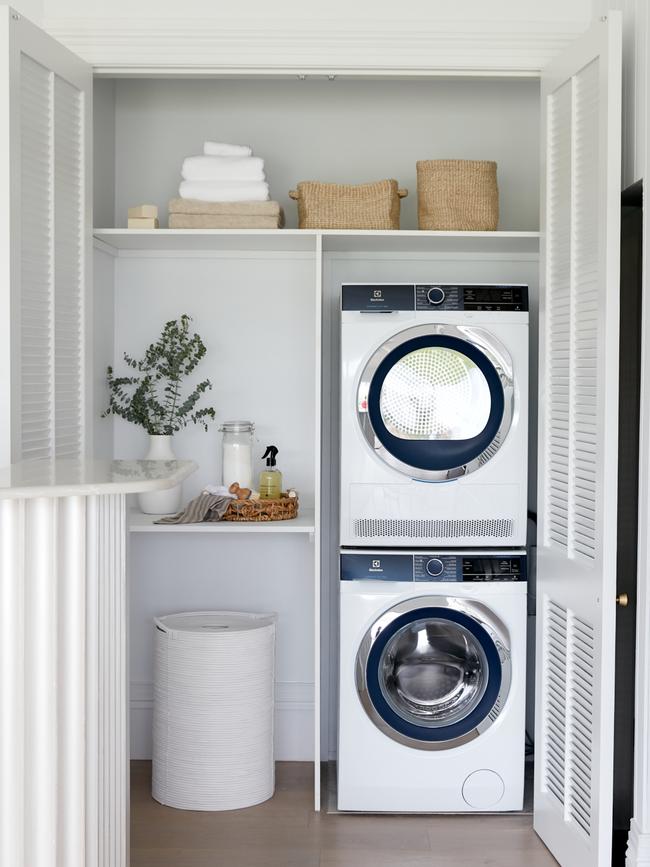
From the hanging pendant light, to brushed gold tapware, sage green panelled cabinetry and twin appliances, it’s a simple yet stylish design you’ll want to pin to your inspiration board. As professional renovators, Three Birds, which is made up of Bonnie Hindmarsh, Lana Taylor and Erin Cayless have seen a laundry or two and they know exactly what this room needs to make it a success and that is the following: custom cabinetry and high-quality appliances.
“Don’t get carried away with beauty at the expense of functionality,” says the trio.
“Make sure you’ve included all the laundry essentials first such as great appliances, good ventilation, lots of storage and then make it all look beautiful,” they add.
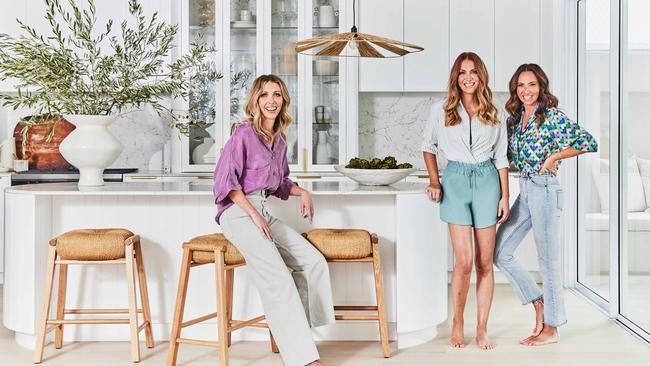
Bonnie, Lana and Erin recommend starting with a vision board gathering inspiration from wherever you find it – think Instagram, hotels, travel mags or Pinterest for example. Something to focus on when scouring magazines and so on is lighting, an important aspect to the perfect laundry.
“You might need task lighting to make sure you can see what you’re doing, and we also love accent lighting, like a pendant, just because it looks so good,” say the team.
As for fixtures and fittings, they recommend choosing durable, quality items which will last for years. At their most recent build the team opted for tumbled brass cupboard pulls and door handles and Electrolux appliances. They have one key laundry tip – always design space to fit a dryer.
“Relying on a washing line during wet periods can make it near impossible to keep your household in clean clothes and bedding,” say the Birds.
“If you have the room, position a front load washer and dryer side-by-side. It frees up lots of bench space above to make room for sorting and folding washing,” they add.
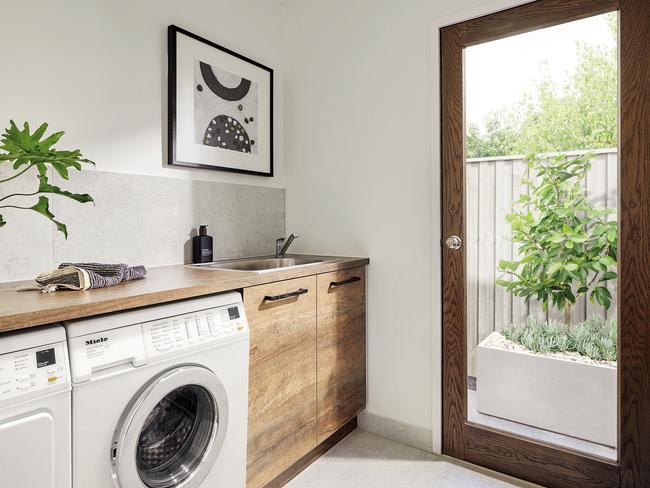
FOUR EASY STEPS TO THE PERFECT LAUNDRY
Make the layout logical
That means putting a bench above your appliances and going big on storage. “Laundry detergent isn’t exactly a hero feature, so when it comes to storage, more is more here,” say the Birds.
Don’t feel you need to match
“A laundry is a discreet zone where you can have a bit of fun and try something different from the rest of the house.”
Choose appliances that will last
Choose appliances that are up to the job now – and in five years time too.
“Opt for new innovation now and future savings later.”
Flood your laundry
“With light and ventilation, not water. Good airflow is key.,” says Bonnie, Lana and Erin.
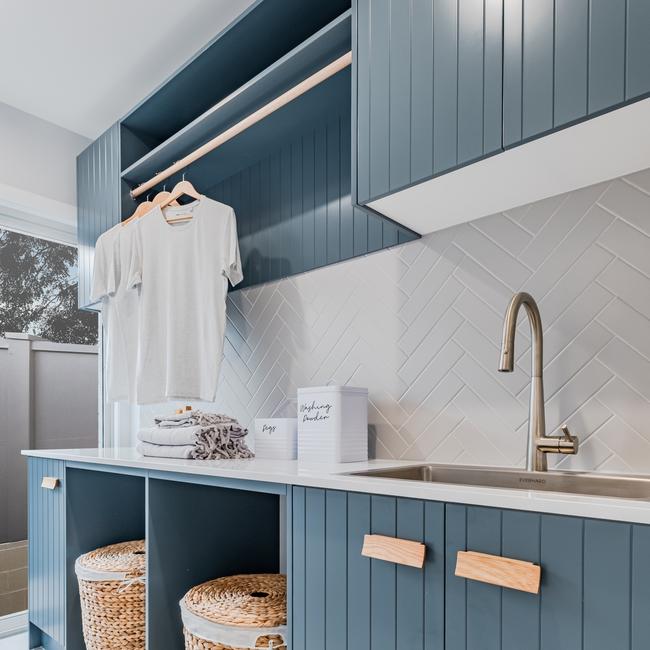
HOW TO MAKE THE PERFECT COFFEE
Covid’s numerous lockdowns have changed a lot about our lives and working from home means it’s harder to pop down to the nearby cafe for a caffeine hit.
But it’s never been easier to make a great cuppa at home.
Rather than just choosing between a stovetop Bialetti machine or Nespresso pods, these days there are a range of products that will make the kind of coffee you’re after, whether it’s a creamy flat white or a refreshing cold brew.
The Aeropress is a modern-day take on the French press and is every bit as good.
Breville’s Barista Express range includes in-built grinders and Jura’s new Z10 machine does hot and cold brew specialty coffee. Jura also comes with the Swiss-brand guarantee that it will be easy to use, clean and maintain.
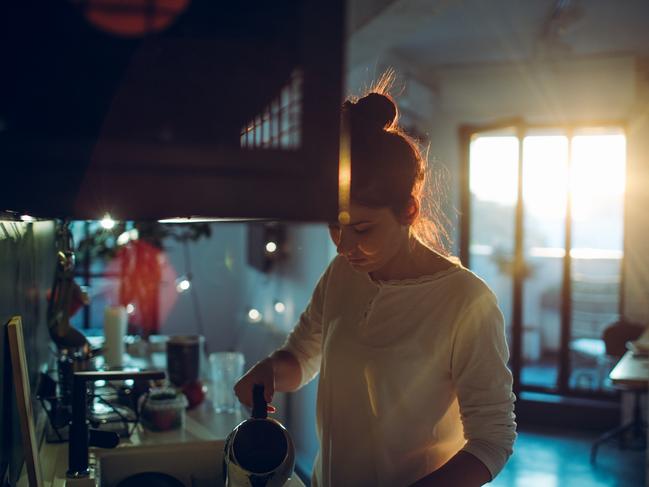
Apollo Joinery Group chief executive Peter Bader says clients are designing their kitchens with coffee machines in mind.
“People are more inclined to hide their kettles and toasters, however, the coffee machine always remains stationary and front and centre,” he says.
“Like any other appliance, people need to take aesthetics into consideration when purchasing a coffee machine to ensure their selection matches their kitchen palette and lifestyle. Safe colours such as black or chrome complement the kitchen while vibrant reds or pastels add personality.”
Single O head trainer, Tobias Aubrey-Poiner, says making coffee at home isn’t as difficult as you may think.
“You don’t necessarily need to buy a whole heap of equipment to make a delicious cup of coffee,” says Tobias.
“You can make a great coffee with a plunger and percolator, or a little espresso machine can give you something more akin to a flat white,” he says. The key requirement for good coffee is the coffee itself, so buy whole beans rather than pre-ground.

“Freshly ground coffee always tastes better, the seeds hold all those flavours,” he says.
“Grind enough for one coffee at a time, it’s applicable for all methods, and you’ll always make a good coffee. Coffee has three variables, coffee, water and brew time — if you can nail that, you’ll have a good coffee.” Alternatively you could spent a bunch of cash at the cafe. But the fact is, these days you don’t have to.
HOW TO MAKE THE PERFECT COFFEE
Get grinding
The key to nailing that ratio of coffee to water and brew time is the grind of the beans, which is why Tobias likes a coffee grinder.
“I would fork out on a grinder before spending money on a machine,” he says. He recommends a conical burr grinder, which is similar to what cafes use. “Blade style grinders are almost like a blender and don’t tend to grind the bean uniformly. You can get some good home grinders from Breville and Sunbeam for about $100-$200.”
Visit thegoodguys.com.au
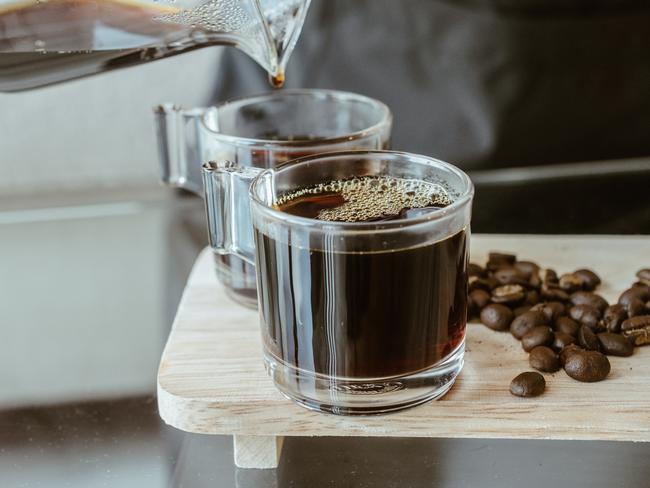
Fresh is best
The coffee you use makes a big difference.
“Up to 21 days after roasting is ideal. A lot of supermarket coffees have use by dates rather than roast dates. It’s great to be able to brew coffee at home, but lots of cafes are struggling, so try to buy beans from them to support them and get a better product,” says Tobias.
“I usually store coffee beans in the pantry, it’s dark, cool and dry. Push all the air out of the bag to limit the amount of oxygen that touches the coffee.”
Savour it
How, and where, you drink your coffee is also a factor to consider.
“Ceramic cups help simulate the cafe experience but I think it’s really about taking time,” says Tobias.
“Being able to take 10 minutes in the morning to relax, have a coffee and start your day as you would if you were out is ideal.” Try to copy what you’d do at a cafe when you sit down at breakfast and have a coffee. Don’t rush it. Take your time and really enjoy every moment.”
HOW TO INVEST IN ART, WISELY
#artcollector is a growing hashtag on Instagram.
Now with 10 million posts on the platform, Australian Contemporary Art Expert, and founder of KAB Gallery, Kerry-Anne Blanket, says the popularity of the hashtag highlights the mainstreaming of art investment as more than just hobby for the wealthy in a post-Covid era.
With contemporary art trends shifting as a result of digitalisation of the industry, Kerry-Anne, believes whether you’re a first-time collector or seasoned investor, understanding the latest contemporary art trends will help to build a collection of value longer-term.

“As artists and galleries alike struggled to keep their head above water throughout the pandemic, what they’ve inadvertently done is opened up the idea of art collection to anyone with a smartphone, challenging the age-old assumption that art investment is purely for the wealthy,” Kerry-Anne explains, plus with the stalling of international travel, many Aussie’s have instead begun instead to look for ways to transform the spaces around them, creating havens of calm in the midst of worldwide panic.
With social media now a driving force behind this shifting art investment landscape, Kerry-Anne says there is a renewed interest in Australian contemporary art, not only for the myriad ways it can transform an interior, but for its potential as a savvy financial investment.
“The increase in online galleries means you can find pieces you love from the comfort of your home, available to suit a range of budgets. With so many other investment avenues unworkable for many of us – home ownership being an obvious one – art investment is an affordable segueway to enjoying the benefits of an appreciating asset, even if your budget is small.”
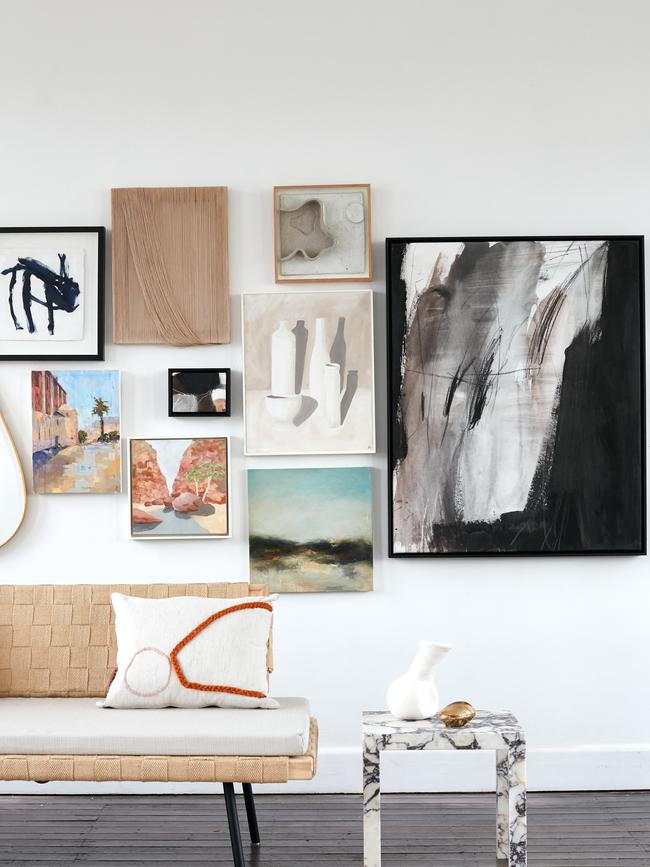
Kerry-Anne advises for those serious about dabbling in art, the contemporary art world is an exciting place to start with a multitude of trends to watch for when seeking to purchase your next artwork – be that for first-time investors, or seasoned collectors.
“Australian contemporary artists are channelling cultural ideas, ideals and changing views, in ever more unique ways. The appeal of contemporary art is vast. It has the ability to encapsulate any scene, object, thought or feeling, and its meaning is as reliant on the artist’s approach as it is to the viewer’s experience.”
HOW TO CREATE A GALLERY ART WALL
Styling with art can add personality and soul to a home. If you own artworks in different styles, various sizes and colours, a gallery art wall is a fun way to display them. Here is a step-by-step guide on how to create one:
Step one: Place all your artworks on the floor and start creating the layout, how you would like to hang it on the wall. Make sure to mix the heights and orientation of your artworks to add variety.
Step two: Mark out on paper or newspaper the size of each artwork and cut them out. If any need to be hung with a screw in the wall, put a cross where the screw should sit.
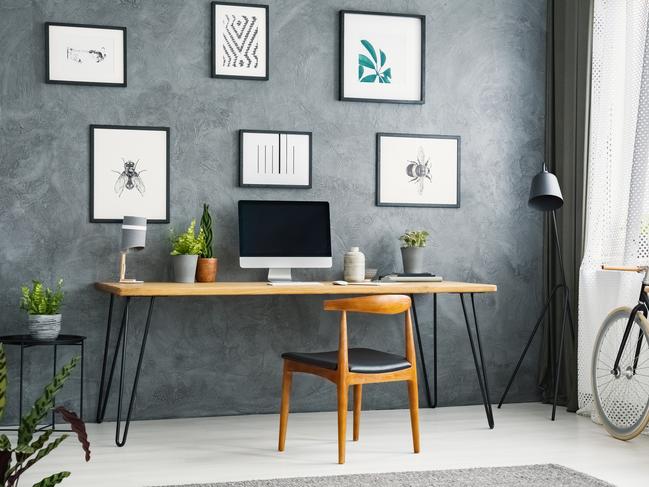
Step three: Stick the paper on the wall in the same arrangement that you laid out already on the floor.
Tip: Make sure the distance between each artwork is roughly the same, for a consistent look.
Step four: Drill any screws into the wall where you have marked them out on the paper then remove the paper.
Tip: If you are drilling into bricks you’ll need a special drill bit to cut through the brick and if you are drilling gyprock, you’ll need to find the stud and make sure you avoid any electrical or pipes.
Step five: Add Velcro strips or 3M hooks to the back of any smaller artworks.
Step six: Remove the brown paper off the wall and hang the art in its place.
Tip: To create cohesion between the artworks and pictures, use similar frames such a black & white frames with a flat profile. They are easy available from most homewares store and are cost effective too.
HOW TO KEEP FOOD FRESHER FOR LONGER
Incredibly, Australians waste 7.3 million tonnes of food each year, according to OzHarvest – that’s enough food to fill 13,000 Olympic sized swimming pools.
We can all do our bit to reduce food waste, including managing how we shop and how we store food.
Recipe creator and food stylist, Sian Redgrave, points out that fresh produce is the main thing we buy and then tend to neglect.
“Planning ahead for the week is a great way to ensure we are only buying what we need but often cooking can be far more impulsive and spontaneous. So any leftover vegetables I love to turn into stock and freeze,” she says.
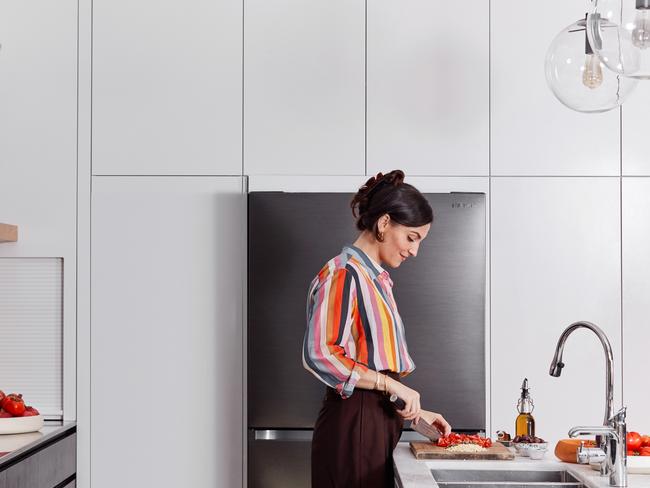
Also storing produce in unbleached vegetable bags and Pyrex containers in the fridge keeps things fresh and reduces the amount of single-use plastic.
Sian’s background in fashion also taught her to save and invest in things that are timeless and to avoid quick fixes.
“I think the same applies to food. Buying organic meat and dairy which has been more sustainably produced and eating less of it, local fruit and vegetables which have not been imported and making more from scratch instead of buying processed food all create a far more mindful approach to eating,” she says.
“Knowledge is power so becoming inspired by what we eat not only from a nutritional perspective but also a sustainability perspective ultimately affects the respect we have for waste and consumption.”
Andrew Wand, director of Home Appliances, Samsung Electronics Australia, says one of the easiest ways to help mitigate any food waste is to store your food correctly.
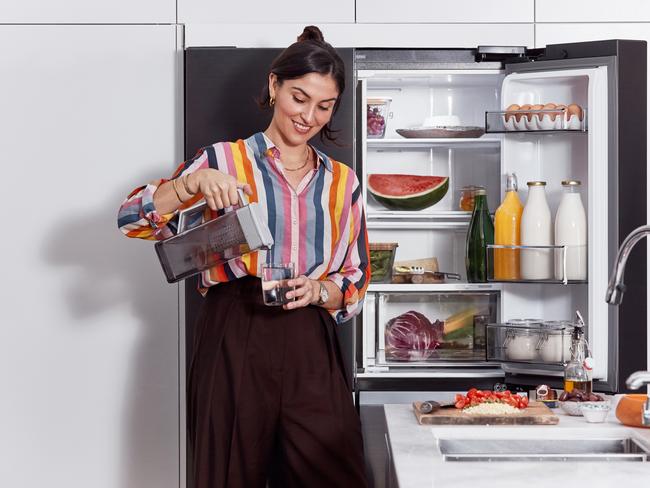
Samsung’s latest French Door refrigerator provides households the opportunity to keep food in ideal conditions and stay fresher for longer through custom shelving, larger capacity crispers and bigger bottle door bins. There’s even a ‘Beverage Centre’ which allows you to access drinks without opening up the whole fridge, keeping the temperature stable.
“The most common causes of household food wastage includes leaving your produce in the refrigerator or freezer for too long. We don’t often think about it but where you place food in the fridge can really affect how long the food lasts,” says Andrew. “Alter your shelving placements to best suit your groceries so that nothing gets misplaced or forgotten.”
TIPS TO KEEP YOUR FOOD FRESHER FOR LONGER
Organisation is key
Making the most of your meat and vegetables comes down to cupboard and fridge organisation says Sian.
“I like to organise my fridge into sections, such as dairy, fruit and veg, and then jarred things like pickles and capers. It’s then easy to see what you already have before you shop and also inspiring to throw together a quick on-hand meal.”
Shop smart
One of the easiest ways to manage food waste is to shop smart. We tend to buy more than needed, therefore it’s important to make a list and stick to it. Create a weekly food chart to make shopping easier.
Fridge storage
Incorrect storage leads to food spoilage. It’s important to store your food strategically.
Save leftovers
Although many people save leftovers from large meals, it is often forgotten in the fridge, and emptied in the bin once it goes bad. Storing leftovers in a clear glass container, rather than in a coloured container, helps ensure you don’t forget the food.
What we waste
Nearly 60 per cent of us have changed how we shop for food in the past 12 months, doing bigger more expensive shops so we can stockpile. This can result in food wastage. On average, Australian’s waste 298kg of food per person.
The top five most wasted foods in Australia are vegetables, bread, fruit, bagged salad and leftovers.
Source: OzHarvest and Southern Cross Austereo Research
HOW TO DIY PATCH A SMALL LEAK AT HOME
In most cases a small leak in your home is easy and, better still, inexpensive to fix.
But left unchecked, even the smallest of dribbles can, and will, cause major structural damage over time.
First let’s look at the basics.
Household leaks are most commonly found in places where you have plumbing, predominantly under sinks in the bathroom and the kitchen.
The next most common leak location is the roof, especially when the integrity of roofing materials has been compromised by items such as a chimneys, skylights and air vents.
Builder Jonathan Hayes, of Tailored Construction Group, says ensuring you stay on top of leaks so that any damage is minimised is as simple as maintaining and regularly checking the areas that are known for leakage.
“Checking your home for leaks is the same as getting your car serviced,” he says.
“It should be done routinely.”
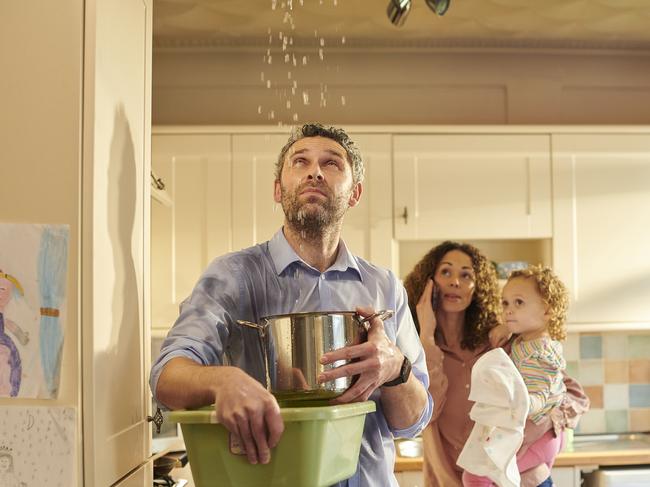
This means a thorough check at least every 12 months by a plumber and a roofer if at all possible. If you’re not willing to do that then you must ensure you resolve any noticeable leaks when you first register them or, you risk long-term and significant damage.
Bec Senyard, a qualified plumber and experienced renovator, who heads up the site theplumbette.com.au, says it’s also worth installing ‘stop tap’ products on all of your taps.
These allow you to shut off water from the mains to a particular tap rather than all of the water on the property.
“These are great because if you have a leak in the kitchen, for instance, a stop tap will isolate the water to that tap only instead of cutting the water off to the whole house while you fix it,” she says.
“There are also flood stop valves. These automatically cut off water if a leak is detected, even if you’re not home.
“They’re great, but you have to remember they are not a complete guarantee.”
Aside from damage, leaks are wasteful.
A leaking tap can drip 20,000L of water a year, according to Queensland Urban Utilities, that’s the amount of water it takes to fill a small pool or spa. Accordingly, whenever you call a plumber out, have them check all the S-traps and flex hoses for leaks to prevent a small drip becoming a bigger problem.
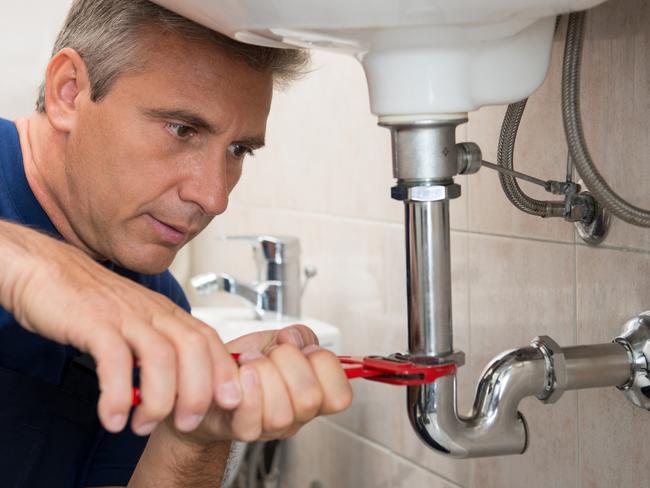
PROBLEM AREAS FOR LEAKS AT HOME
The roof
Anything that penetrates the roof, like a chimney, air vent or skylight, requires a roof-penetration seal, such as Dektite, which hugs the pipe to prevent water or moisture getting in.
“This flashing only has a lifespan of two to five years,” says Jonathan.
“People don’t realise this and don’t check it for wear and tear. It only costs a few hundred dollars to replace the flashing, but if left unchecked, it could result in wet rot in the timber and a sagging roof that will need to be replaced.”
The kitchen and bathroom sink
Leaks often develop under the kitchen or bathroom sink where the PVC S-trap or flexi hose commonly leaks.
“In the bathroom, it’s often a build-up of hair that can cause a leak and in the kitchen it’s a build-up of animal or cooking fats,” says Jonathan.
“A plumber can replace the S-trap or flex hose quickly and inexpensively, but if it’s left to leak, over time the timber can rot and you’ll have to replace the kitchen cabinet or bathroom vanity.”
The toilet
Leaks in the toilet cistern are also common, says Bec and are often caused by aged rubber washers that need replacing because they have worn and perished.
“Blockages caused by flushing wipes, facial tissues and paper towels, a problem that was particularly prevalent during Covid thanks to widespread toilet paper shortages, can also cause blockages,” she says.
Warning: be careful what you flush.
LIFE HACKS: TIPS ON HOW TO DIY PLASTER LIKE A PRO
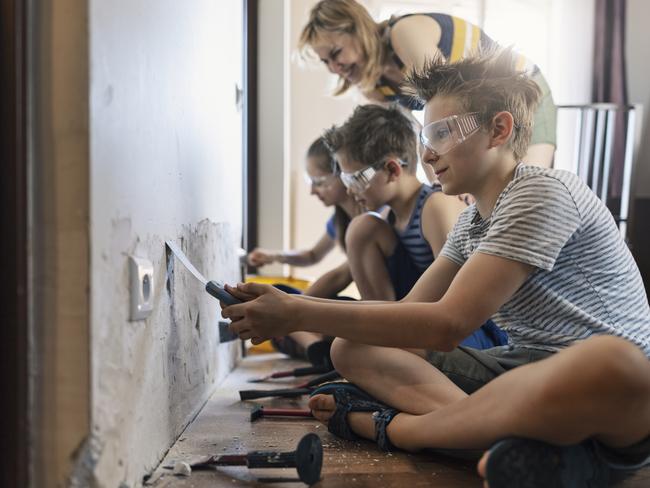
It’s not the easiest job in the world, but if you follow a few basic rules with your do-it-yourself plastering, you can achieve amazing results.
For the beginner DIY-er few things are as intimidating as plastering.
It’s the final, crucial step that will give your renovation a professionally finished surface ready for painting. Get it right and it’s invisible to the naked eye. Stuff it up and it will drive you mad for years to come.
Plaster is found in almost every home.
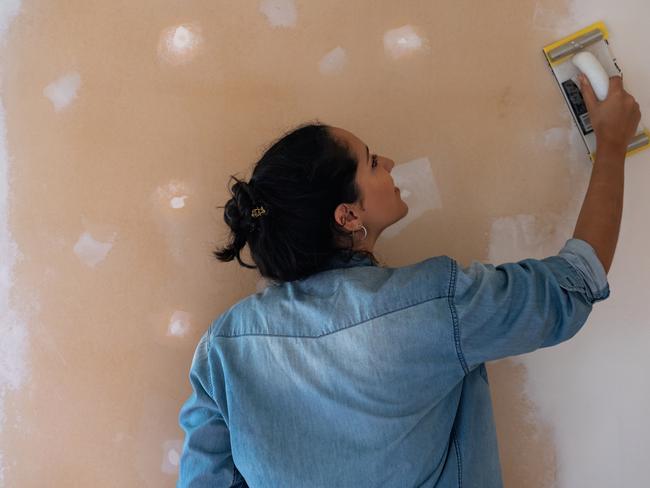
Most commonly, it covers the join where two sheets of plasterboard, sometimes called drywall or Gyprock, meet. It is used to cover the dimples created by nails that fix plasterboard sheeting to the stud wall, and it is also used to patch holes or blemishes in walls and ceilings. It’s versatile and virtually magic, and if you can become a master plasterer, the home renovation universe is yours.
What makes the plastering process so daunting for beginners is that if it’s done badly, when painted, imperfections will be glaringly obvious when light from different angles (called glancing light) hits the area. In addition, plaster can crack over time, for a variety of reasons, including poorly mixed or applied plaster.
Getting the plaster layers right is crucial
Brisbane-based plasterer Barry Hawkins, who has more than 35 years’ experience, says beginners tend to make the same mistakes.
“Any join you plaster over has got to have three coats and I’ve seen many trying to take shortcuts,” he says.
“It’s always going to take three coats and getting the layers right is the trick,” he says.
“And there are no shortcuts.”
Decorative plasterer Ryan Lowseck, whose business The Artisan Trowel does a mix of commercial and residential work, agrees that beginners face an uphill battle getting plastering bang on.
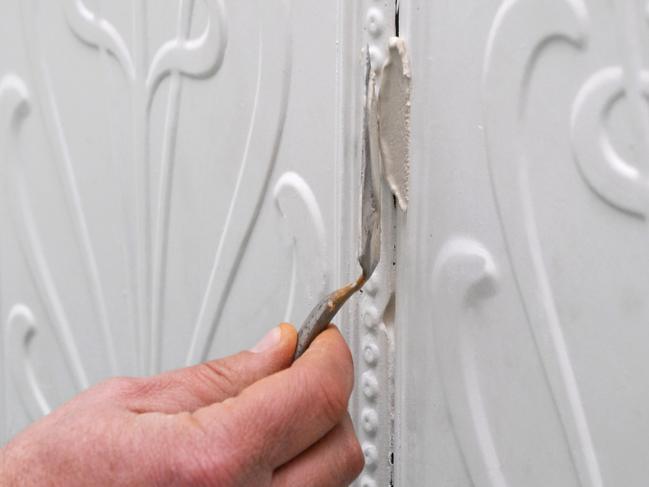
“Mistakes often begin with the plasterboard. (Beginners) may not know how to sheet the walls properly and they put the plasterboard joins in the wrong place and this can cause a lot of issues, including cracking,” he says.
“Another common mistake is overflushing – making the plaster too thick.
“I’ve seen big chunks of plaster in the joins and the only way to fix it was to rip it all out and start again.”
However, if you are going to tackle the job yourself, the experts agree: do your homework first. And understand there are certain areas where you must call in a professional, such as wet areas.
You’ll also find plenty of videos explaining plastering clearly and concisely.
TOP HOW-TO, DIY PLASTERING TIPS FOR BEGINNERS
1. Less is more: Don’t fall into the trap of plaster compound that is too thick. It will look lumpy and worse, unprofessional when painted over.
2. Start small: Start with a small patch job that will give you practice working with plaster and plasterboard, and will teach you the basics of mixing the compound.
A wall dent or crack or a gap between the wall and the skirting board is a great place to begin.
Consider the weather
Humidity can be a factor in your plastering. If possible, do plastering on a dry day, or turn on the airconditioning or a fan if possible to ensure plaster dries properly between layers. Consider calling in a professional if the job seems too big.
Many experienced DIY-ers agree that getting the plastering right is crucial to the success of the entire renovation and sometimes, if there’s much to be done, it’s best to leave it to the professionals.
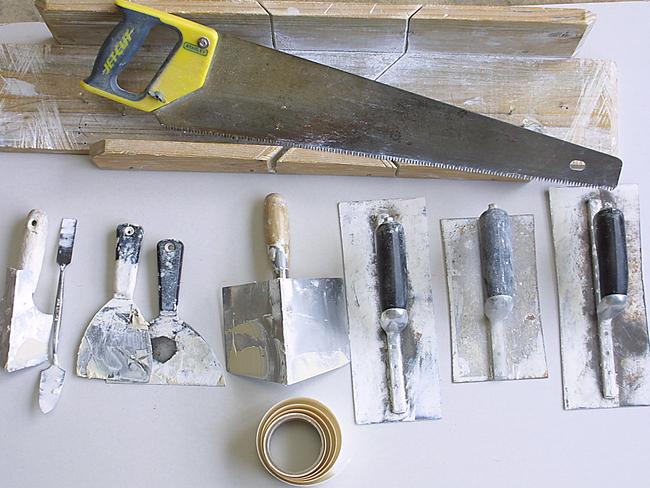
Recessed joins 101
Step 1: Measure the length of paper tape you’ll need.
Step 2: Apply the first base coat of joint compound, ensuring a smooth, thin layer is spread evenly
across the recessed join.
Step 3: Apply the paper tape over the centre of the join.
Step 4: Apply a thin layer of plaster compound over the paper tape.
Step 5. Allow drying time according to the instructions on the packet.
Step 6: Apply second base coat, wider than the first. Allow to dry.
Step 7: Sand off any imperfections and smooth over the plaster.
Step 8: Apply final finish coat. Allow to dry. Sand smooth.




